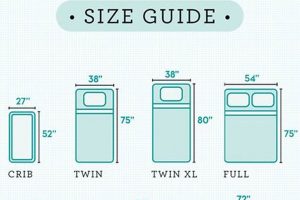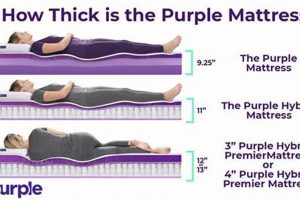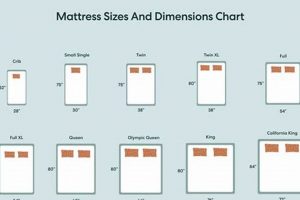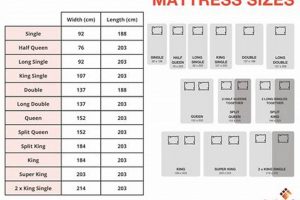This specialized bedding provides a comfortable sleeping surface specifically designed for recreational vehicles. Its dimensions generally measure around 60 inches wide by 75-80 inches long, though slight variations can occur to accommodate different RV layouts. These mattresses are often constructed with lighter materials like foam or innerspring coils to minimize weight and ease installation within the confined space of an RV bedroom.
The advantage of using a properly sized sleeping solution in a recreational vehicle relates to optimized space utilization, enhanced sleep quality during travel, and reduced overall vehicle weight. Historically, RV mattresses were often an afterthought, leading to discomfort. However, increasing awareness of the importance of quality sleep has driven manufacturers to develop more advanced and comfortable options. Benefits include better back support, temperature regulation, and resistance to motion transfer, contributing to a more restful experience on the road.
Considering the specific needs of RV owners, the following discussion will delve into various aspects of selecting and maintaining this type of bedding. This includes materials, construction, comfort levels, and considerations for optimal fit within different recreational vehicle models. Furthermore, cleaning and care tips to prolong the lifespan of the sleep surface will be addressed, ensuring a hygienic and enjoyable travel experience.
Essential Guidance for RV Queen Size Mattress Selection and Care
The following guidelines offer practical advice for choosing, using, and maintaining a bedding solution intended for recreational vehicle applications, promoting enhanced comfort and longevity.
Tip 1: Accurate Measurement is Paramount. Precisely measure the available space within the RV bedroom before considering any purchase. Confirm that the intended sleep surface dimensions align with the compartments specifications, accounting for any obstructions or confined corners. An inaccurate measurement may result in an ill-fitting product.
Tip 2: Prioritize Lightweight Materials. Given the weight constraints inherent in RV travel, opt for bedding composed of lighter materials, such as foam, latex, or specialized innerspring constructions designed for reduced weight. Excessive weight can negatively impact fuel efficiency and vehicle handling.
Tip 3: Evaluate Density and Firmness. Select a density and firmness level that corresponds to individual sleep preferences and physical needs. Consider factors such as body weight, sleeping position, and any existing back or joint conditions. A trial period, if available, can be beneficial in determining suitability.
Tip 4: Investigate Construction Quality. Scrutinize the construction methods and materials used in the mattress. Reinforced seams, durable covers, and high-quality internal components contribute to extended product lifespan and sustained comfort levels.
Tip 5: Consider Breathability and Temperature Regulation. RV environments can be prone to temperature fluctuations. Select a mattress with breathable materials or features designed to promote airflow, mitigating heat retention and enhancing sleep comfort during varying weather conditions.
Tip 6: Implement Protective Measures. Employ a waterproof mattress protector to safeguard against spills, stains, and moisture accumulation. This measure can prevent premature degradation of the materials and maintain a hygienic sleep environment.
Tip 7: Rotate Regularly. Periodically rotate the mattress (typically every 3-6 months) to promote even wear and prevent localized compression. This practice helps to extend the lifespan of the bedding and maintain consistent comfort levels.
Tip 8: Adhere to Cleaning Recommendations. Follow the manufacturer’s instructions for cleaning and maintenance. Regular vacuuming and spot cleaning can help remove dust, allergens, and minor stains, contributing to a healthier sleep surface.
By adhering to these guidelines, RV owners can maximize the comfort, durability, and hygiene of their sleeping environment, leading to more restful and enjoyable travel experiences.
The subsequent section will focus on the selection process and the features available, allowing you to find the perfect fit.
1. Dimensions
The proper dimensions of a recreational vehicle sleeping surface are paramount for optimizing comfort and functionality within the limited space of an RV. Precise measurements ensure a correct fit, maximizing usable space and preventing obstructions.
- Standard Queen vs. RV Queen Dimensions
A standard queen typically measures 60 inches wide by 80 inches long. An RV queen, however, often deviates, commonly found in lengths of 75 inches to accommodate space constraints. Failure to recognize this difference can result in a poor fit, impeding movement within the RV.
- Width Variations and Wheel Well Interference
While the width generally remains consistent around 60 inches, variations can occur between manufacturers. Furthermore, wheel well intrusions within the RV layout can necessitate narrower dimensions in certain areas, requiring careful consideration of the sleeping surface’s overall shape and adaptability.
- Thickness and Headroom Considerations
The thickness of the bedding impacts headroom, particularly in RVs with overhead storage or low ceilings. A thicker sleeping surface, while potentially more comfortable, can restrict movement and create a feeling of confinement. Balancing comfort with spatial constraints is essential.
- Custom Dimensions and Adaptability
In some instances, custom-sized solutions may be required to fully utilize available space or accommodate unusual RV layouts. Manufacturers offer options for creating bespoke bedding solutions that conform to specific dimensions, ensuring a seamless integration within the vehicle’s interior.
Therefore, understanding and meticulously addressing dimensional considerations is critical when selecting an appropriate sleeping surface for recreational vehicles. Overlooking these aspects can lead to discomfort, spatial inefficiencies, and potential obstructions within the confined environment of an RV.
2. Material Weight
Material weight is a critical consideration in the selection of an RV queen-size mattress, influencing fuel efficiency, payload capacity, and ease of handling within the confines of a recreational vehicle.
- Impact on Fuel Efficiency
Excess weight directly correlates with reduced fuel economy. A heavier mattress increases the overall vehicle mass, requiring more energy for propulsion. Opting for lightweight materials, such as foam or specialized innerspring systems, mitigates this effect, leading to improved gas mileage and reduced fuel costs during travel. For example, a difference of 20 pounds in weight can be significant on long trips.
- Effects on Payload Capacity
Recreational vehicles have strict payload limits, dictating the maximum weight of cargo and passengers. A heavy mattress consumes a significant portion of this capacity, potentially restricting the amount of personal belongings and supplies that can be carried. Choosing lightweight materials ensures compliance with weight restrictions and maximizes usable payload.
- Installation and Maneuverability
A lighter mattress is easier to install and maneuver within the tight spaces of an RV bedroom. This simplifies the process of making the bed, rotating the mattress for even wear, and accessing storage compartments beneath the sleeping platform. Conversely, a heavy mattress can be cumbersome and require assistance to handle.
- Long-Term Structural Considerations
Consistent heavy weight can contribute to increased stress on the RV’s structural components, particularly the bed frame and support system. This can lead to premature wear and potential damage over time. Lighter materials minimize this stress, prolonging the lifespan of the RV’s interior structures.
Therefore, the judicious selection of lightweight materials for RV queen-size mattresses is essential for optimizing fuel efficiency, preserving payload capacity, enhancing maneuverability, and minimizing long-term structural strain on the recreational vehicle. Careful attention to this factor contributes to a more efficient and enjoyable travel experience.
3. Firmness Level
The firmness level of a recreational vehicle sleeping surface is a critical determinant of sleep quality and physical comfort. Its selection should be carefully considered, aligning with individual needs and preferences to mitigate discomfort and promote restorative rest during travel.
- Spinal Alignment and Posture
Mattress firmness directly influences spinal alignment during sleep. A surface that is too soft may cause excessive sinking, leading to spinal curvature and potential back pain. Conversely, an overly firm surface may not conform to the body’s natural contours, creating pressure points and discomfort. An appropriate firmness level supports the spine’s natural alignment, minimizing strain and promoting healthy posture.
- Pressure Point Relief and Circulation
Firmness level impacts pressure distribution across the body. Softer surfaces may inadequately support heavier areas, leading to concentrated pressure and restricted circulation. Firmer surfaces, while providing support, may create pressure points on bony prominences. A balanced firmness level distributes weight evenly, alleviating pressure points and promoting healthy blood flow.
- Sleeping Position Compatibility
Different sleeping positions necessitate varying firmness levels. Side sleepers typically benefit from softer surfaces that conform to the shoulders and hips, reducing pressure. Back sleepers generally require medium-firm surfaces that support the lumbar region. Stomach sleepers often prefer firmer surfaces to prevent excessive sinking and spinal strain. Selecting a firmness level compatible with one’s primary sleeping position is crucial.
- Weight Distribution and Support
Body weight influences the perception of firmness. A lighter individual may find a medium-firm mattress too hard, while a heavier individual may find it too soft. The chosen firmness level should adequately support the individual’s weight, preventing excessive sinking or a feeling of instability. Proper weight distribution contributes to overall comfort and reduces the risk of pain or discomfort.
The connection between firmness level and recreational vehicle sleeping solution is therefore a personal one. By factoring in spinal alignment, pressure relief, sleeping position, and weight distribution, owners can optimize their comfort and improve sleep quality while in transit.
4. Construction Quality
The overall construction quality of a recreational vehicle sleeping surface directly impacts its durability, longevity, and ability to provide consistent comfort during extended use. This facet encompasses materials, assembly techniques, and design features that contribute to the product’s structural integrity and performance.
- Seam Integrity and Fabric Durability
The seams connecting the various fabric panels of a sleeping surface are critical points of stress. Weak or poorly stitched seams are prone to unraveling, compromising the structural integrity of the mattress. Similarly, the quality and durability of the fabric used in the cover directly affect resistance to tears, abrasions, and staining. Robust stitching and high-quality, durable fabrics are essential for withstanding the rigors of RV travel and prolonged use. As an example, double-stitched seams with reinforced corners enhance the resilience of the mattress cover, preventing premature wear and tear.
- Core Material Density and Resilience
The core material, whether foam, innerspring coils, or a combination thereof, provides the primary support and cushioning. High-density foam or resilient coil systems maintain their shape and supportiveness over time, resisting compression and sagging. Low-density foam or poorly constructed coil systems are prone to deformation, leading to uneven support and reduced comfort. For instance, high-density memory foam is known for its ability to contour to the body and maintain its shape, while individually wrapped coils minimize motion transfer and provide targeted support.
- Edge Support Systems
Edge support systems reinforce the perimeter of the mattress, preventing edge collapse and maximizing the usable sleep surface. Weak or non-existent edge support can lead to a feeling of instability and make it difficult to get in and out of bed. Reinforced edges, often achieved through the use of high-density foam encasements or specialized coil designs, enhance stability and prevent roll-off. This is especially important in RVs where space is limited, and every inch of the sleeping surface is valuable.
- Ventilation and Moisture Control
The construction should facilitate adequate ventilation and moisture control. Breathable materials and designs promote airflow, preventing the buildup of heat and moisture, which can lead to discomfort and microbial growth. Poorly ventilated mattresses are more prone to retaining heat and moisture, creating an unhealthy sleeping environment. Features such as open-cell foam or ventilated coil systems enhance airflow and promote a cooler, drier sleep experience.
In summary, a well-constructed sleeping surface for recreational vehicles integrates durable materials, robust assembly techniques, and thoughtful design features to ensure long-lasting comfort and performance. These construction attributes directly impact the mattress’s ability to withstand the challenges of RV travel, providing a consistent and supportive sleep experience.
5. Breathability
Breathability in the context of an rv queen size mattress pertains to the material’s capacity to permit airflow and facilitate moisture evaporation. This characteristic is crucial due to the typically compact and often poorly ventilated environments within recreational vehicles. Limited airflow exacerbates temperature fluctuations and can lead to moisture accumulation, fostering discomfort and potentially compromising the mattress’s integrity. For example, without adequate breathability, body heat becomes trapped, leading to overheating, which can disrupt sleep and promote sweating. This moisture then permeates the mattress, creating a breeding ground for mold and bacteria.
The selection of breathable materials directly impacts the sleep experience. Open-cell foams, such as latex or certain types of memory foam, possess inherent breathability due to their structure. In contrast, closed-cell foams offer less airflow. Similarly, mattress covers made from natural fibers like cotton or bamboo promote better ventilation than synthetic alternatives. The incorporation of ventilation channels within the mattress core can further enhance airflow. Consider the practical scenario of an RV traversing a humid climate; a mattress lacking breathability will retain moisture, resulting in a damp, uncomfortable sleeping surface. Conversely, a breathable mattress facilitates moisture evaporation, keeping the occupant drier and more comfortable.
In summary, breathability is a significant attribute for RV queen size mattresses, especially given the environmental conditions often encountered during travel. Choosing materials and designs that promote airflow mitigates heat retention, reduces moisture accumulation, and contributes to a healthier and more comfortable sleep environment within the confined space of a recreational vehicle. The challenge lies in balancing breathability with other desirable mattress characteristics, such as support and durability, to achieve optimal performance.
6. Protective Measures
Protective measures are essential for preserving the integrity and extending the lifespan of a sleeping surface within the demanding environment of a recreational vehicle. These strategies mitigate potential damage from moisture, stains, allergens, and physical wear, safeguarding the investment in a rv queen size mattress and maintaining a hygienic sleeping environment.
- Waterproof Mattress Encasements
Waterproof mattress encasements provide a complete barrier against liquids, preventing spills, accidents, and condensation from penetrating the mattress core. These encasements are particularly important in RVs, where humidity and condensation are common due to fluctuating temperatures and limited ventilation. For example, a waterproof encasement can prevent mold and mildew growth caused by a spilled drink, preserving the mattress’s hygiene and preventing allergic reactions. The implication is a more sanitary sleeping environment and prolonged mattress lifespan.
- Allergen-Resistant Covers
Allergen-resistant covers create a barrier against dust mites, pet dander, and other common allergens, reducing the risk of allergic reactions and respiratory problems. These covers are often made from tightly woven fabrics that prevent allergens from penetrating the mattress. For example, using an allergen-resistant cover can significantly reduce dust mite populations within the mattress, alleviating symptoms for individuals with allergies or asthma. The benefit is a healthier sleep environment, particularly for allergy sufferers.
- Mattress Pads and Toppers
Mattress pads and toppers offer an additional layer of protection against stains, wear, and tear. They can be easily removed and washed, preventing damage to the underlying mattress. For instance, a thick mattress pad can absorb spills and protect the mattress from soiling, while also adding an extra layer of comfort. The result is increased longevity and easier maintenance of the core mattress.
- Regular Cleaning and Maintenance
Regular cleaning and maintenance, including vacuuming, spot cleaning, and airing out the rv queen size mattress, are crucial for preventing the buildup of dust, dirt, and allergens. Vacuuming removes surface debris, while spot cleaning addresses stains and spills promptly. Airing out the mattress periodically allows moisture to evaporate, preventing mold and mildew growth. An example is vacuuming the mattress monthly to remove dust mites and airing it out seasonally to eliminate trapped moisture. A consistent cleaning routine maintains hygiene and prolongs mattress life.
The implementation of these protective measures enhances the durability, hygiene, and overall comfort of an rv queen size mattress. By safeguarding against moisture, allergens, and physical wear, these strategies contribute to a more enjoyable and healthier travel experience, while also protecting the investment in quality bedding.
Frequently Asked Questions
This section addresses common inquiries and misconceptions regarding sleeping surfaces designed for recreational vehicles, providing clear and concise information for prospective purchasers.
Question 1: What distinguishes a standard queen mattress from one designed for RV use?
An RV queen size mattress typically possesses a shorter length than a standard queen, often measuring 75 inches instead of 80 inches, to accommodate spatial constraints within recreational vehicles. Dimensional variations can exist. Verification of specific measurements is essential prior to purchase.
Question 2: Are specialized bedding solutions essential for recreational vehicles, or can standard mattresses be adapted?
While standard mattresses can technically be utilized, they frequently present challenges regarding fit, weight, and maneuverability within confined RV spaces. A specialized RV queen size mattress is often recommended for optimized space utilization and comfort.
Question 3: What considerations are paramount when selecting a sleeping surface for a recreational vehicle?
Key considerations include accurate dimensional measurements, material weight, firmness level, construction quality, breathability, and the implementation of protective measures to mitigate wear and moisture damage.
Question 4: How does the weight of a mattress influence recreational vehicle performance?
Excessive mattress weight negatively impacts fuel efficiency, reduces payload capacity, and can strain the vehicle’s structural components. Opting for lighter materials, such as foam or specialized innerspring systems, is advisable.
Question 5: How can condensation and moisture buildup within an RV be effectively managed to protect the sleeping surface?
Employing waterproof mattress encasements, utilizing breathable materials, and ensuring adequate ventilation within the RV are crucial for preventing moisture accumulation and mitigating the risk of mold or mildew growth.
Question 6: What cleaning and maintenance protocols are recommended for a mattress within a recreational vehicle?
Regular vacuuming, spot cleaning of stains, and periodic airing of the mattress are essential for removing dust, allergens, and moisture, thereby promoting a hygienic sleeping environment.
Careful consideration of these factors will contribute to the selection of a sleeping solution that optimizes comfort, durability, and hygiene within the unique context of recreational vehicle travel.
The succeeding section will focus on optimizing your travel experience.
Concluding Remarks
This examination has elucidated the multifaceted considerations surrounding “rv queen size mattress” selection and maintenance. From dimensional accuracy and material weight to firmness preferences and protective measures, each element directly influences comfort, longevity, and the overall travel experience. A judicious approach to these factors yields a more restful and supportive sleep environment within the confines of a recreational vehicle.
The information presented underscores the significance of informed decision-making. Careful evaluation and proactive care not only preserve the investment in quality bedding but also contribute to enhanced well-being during travel. Continued diligence in selecting and maintaining appropriate sleeping solutions is essential for maximizing the benefits derived from recreational vehicle ownership.



![Best Queen Size Foldable Mattress [Guide] Organic & Natural Mattress Buyer’s Guide: Non-Toxic Sleep Solutions Best Queen Size Foldable Mattress [Guide] | Organic & Natural Mattress Buyer’s Guide: Non-Toxic Sleep Solutions](https://mattressworldpa.com/wp-content/uploads/2025/07/th-2272-300x200.jpg)


![Best Queen Size Floor Mattress [Guide] Organic & Natural Mattress Buyer’s Guide: Non-Toxic Sleep Solutions Best Queen Size Floor Mattress [Guide] | Organic & Natural Mattress Buyer’s Guide: Non-Toxic Sleep Solutions](https://mattressworldpa.com/wp-content/uploads/2025/07/th-2269-300x200.jpg)
